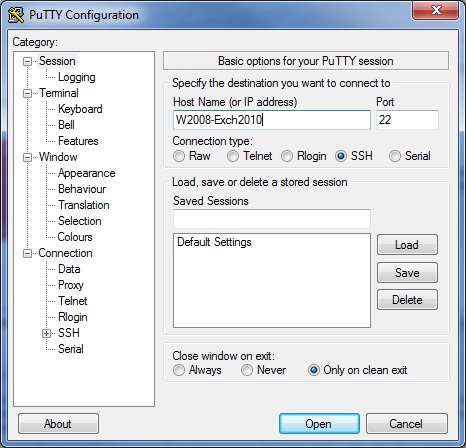
$row.HBAtype = $qlR1.Match($_).Groups. $row = “” | Select ESXname, HBAtype, HBAfirmware, HBAdriver, BIOS # Extract the required info from the $msg variable $msg = Invoke-Expression -command $command $command = $plink + ” ” + $plinkoptions + ” ” + $User + + $computer + ” ” + $remoteCommand $qlR2 = ”Firmware version (+).+Driver version (+)” Now we are on a server with IP 10.10.20.2 and we are sshing to 10.10.20.21. Use the SSH Client to connect to SSH Server as shown below. Run the following commands in PowerShell. Open your Powershell with Administrator access to do this.
#POWERSHELL PUTTY SSH INSTALL#
If you do not trust this host, press Return to abandon the Install SSH Client on Windows using PowerShell. If you want to carry on connecting just once, without If you trust this host, enter “y” to add the key to Have no guarantee that the server is the computer you The server’s host key is not cached in the registry. We claim version: SSH-2.0-PuTTY_Release_0.62ĭoing Diffie-Hellman key exchange with hash SHA-256 (PowerShell) Convert PuTTY Private Key (ppk) to OpenSSH (pem) Convert a PuTTY format private key file (.ppk) to OpenSSH (.pem). I’m having the same problem as you but i can’t seem to get the script working. Web API Categories ASN.1 Amazon EC2 Amazon Glacier Amazon S3 Amazon S3 (new) Amazon SES Amazon SNS Amazon SQS Async. Plink.exe -ssh $line.Server -l $Username -pw $Password This was simply achieved by using echo to pipe the user input to the selected command and then exit the SSH session, the wrapper will then invoke the plink executable a second time to run the required command and pass a set of variables as below Įcho y | plink.exe -ssh $line.Server -l $Username -pw $Password exit Therefore, this required me to modify the commands invoked from the wrapper to first connect and accept to store the servers host key in cache. This would force the commands invoked to halt until user input had been received. If you do not trust this host, press Return to abandon the connection. If you want to carry on connecting just once, without adding the key to the cache, enter “n”. The server’s rsa2 key fingerprint is: ssh-rsa 2048 xx:xx:xx:xx:xx:xx:xx:xx:xx:xx:xx:xx:xx:xx:xx:xx If you trust this host, enter “y” to add the key to PuTTY’s cache and carry on connecting. You have no guarantee that the server is the computer you think it is. The first obstacle was that when connecting using SSH to connect to a server for the first time you will prompted to trust the host key of the server as below: If the operating system was UNIX, the plan was to invoke a SSH session remotely using PuTTY Plink and to invoke the command and pass a set of parameters. Afterwards, save the private key on your Windows computer.I was recently compiling a script which would act as a wrapper to invoke commands depending on the hosts operating system (which was read from a file) and passes a set of parameters.
#POWERSHELL PUTTY SSH PASSWORD#
After you create the pair, add the public key to your server and disable password logins.

And you also have ssh-keygen available on Windows, which you can use in the command prompt.

There are many methods to create key pairs for SSH authentication. Fail2ban blocks multiple attempts from the same IP, but another IP will try different passwords until one of them gets lucky.
#POWERSHELL PUTTY SSH PLUS#
They are much more secure than using the commonly recommended scheme of passwords plus fail2ban. Zombie computers from botnets constantly scan and try to bruteforce passwords on OpenSSH servers. However, it is recommended that instead of passwords you use SSH keys. Just type yes to accept the fingerprint, and then type your password (characters won’t be displayed on screen). When you log in with a password, it’s easy.


 0 kommentar(er)
0 kommentar(er)
